Introduction
The focal length is the basic description of a photographic lens, usually represented in millimeters. It is not the actual length of the lens, but it is a calculation of an optical distance from the point where light rays converge to form a sharp image to the digital sensor of the digital camera. The focal length of a lens is determined when the lens is focused at infinity, (i.e. when the light rays come approximately horizontal and perpendicular to the lens axis).
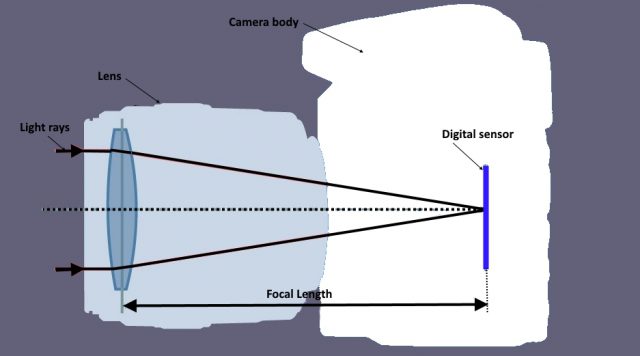
Focal length is fairly easy to understand with a lens that has a single element, but most camera lenses are made up of lots of separate individual elements. These compound lenses have an effective distance from the image plane, somewhere among all the elements and groups, and the further away from the image plane that is, the longer the focal length. And so when you focus on something closer than infinity and the lens is moved further away from the sensor, the lens will get longer.
What does the focal length tell us?
What we need to know, as photographers, is what focal length means to our images. When we talk about lenses, the focal length is not only related to the lenses’ physical length, the linear measurement is representative of an angular field of view.
The value of the focal length tells us two things:
1-The angle of view (how much of the scene will be captured).
2-The magnification (how large individual elements will be)
The longer the focal length, the narrower the angle of view and the higher the magnification.
The shorter the focal length, the wider the angle of view and the lower the magnification.
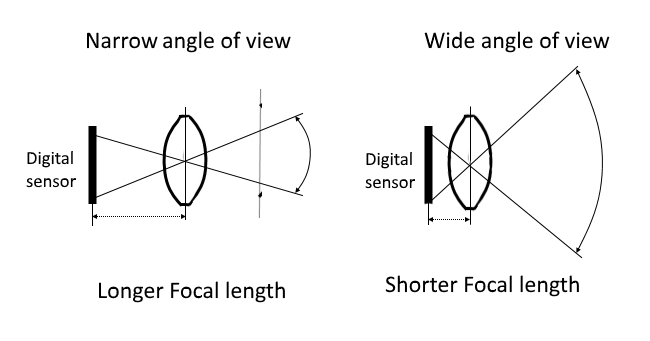
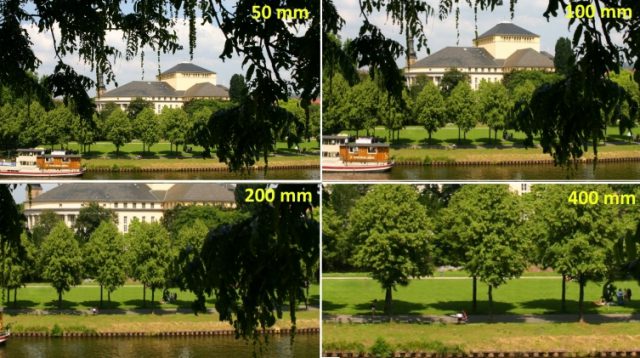
Angle of view
Lens manufacturers often publish the term “angle of view” or “maximum angle of view” in lens specifications, because they define what the lens is capable of seeing in degrees.
The angle of view of a photograph or camera is a measure of the proportion of a scene included in the image. Simply said: How many degrees of view are included in an image. A typically fixed lens camera might have an angle of view of 50°, a fisheye lens can have an angle of view greater than 180 °.
There are three measures of the angle of view of a lens, Horizontal (HAOV), the Vertical angle of view (VAOV), and Diagonal angle of view (DAOV).
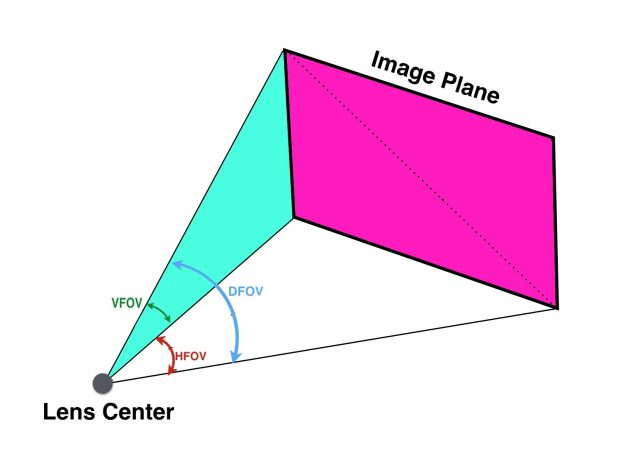
Lens manufacturers often publish the term “angle of view” or “maximum angle of view” in lens specifications, because they define what the lens is capable of seeing in degrees. For example, the Canon 50 mm lens has a maximum angle of view of 47°, while Canon 100 mm lens has a maximum angle of view of only 24° when used on a full-frame camera.
Crop factor
The digital sensor of a camera is often much smaller than the 35mm film (full-frame), because of high production cost. This reduction of the sensor size results in the cutting of the image corners, the process that photographers call “cropping”. The interesting thing is that the image is not cut by the sensor or the camera – parts of the image are simply ignored. You may check my post about full frame vs crop sensor HERE.
To have the same field of view as the 135mm mounted on a full-frame camera, you would need a 100mm lens on a cropped sensor camera (1.3 X). For example, if you were standing from one spot and could fit a building in your frame using a 135mm lens on a full-frame/35mm camera, to be able to fit that same building on a cropped sensor camera, you would need to have a much wider lens with a focal length of 100mm.
The below video shows the change in the angle of view according to the change in focal length:
The following table shows the different values of the angle of view for some Canon lenses with different sensor sizes.
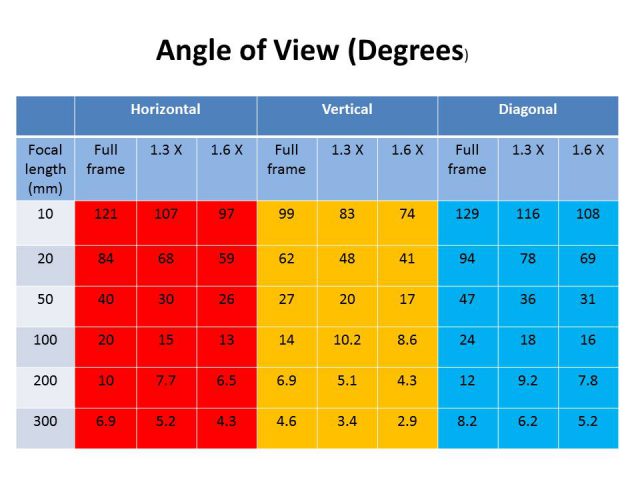
Although you will never use the figures in the above table, as a photographer, it surely gives you what will the increase the focal length will do to the angle of view concerning different crop factors.
Focal length and perspective
Some photographers say that focal length determines the perspective of a photo, but the fact is perspective changes only with your location relative to the subject, if one tries to fill the frame with the same subjects using a wide-angle and telephoto lens, then perspective does indeed change because one is forced to move closer or farther from their subjects. That is why the wide-angle lens exaggerates or stretches perspective, whereas the telephoto lens compresses or flattens perspective.
Focal length and camera Shake
When you handhold a camera, no matter how steady your hands are, the camera will be moving when you depress the shutter release. This movement causes blur in an image at varying degrees; sometimes not noticeable and other times, it is a real problem.
Unfortunately, when you use higher focal lenses, the telephoto lenses, this shaking or movement is amplified by the fact that the field of view of the lens is smaller than that of wide-angle or normal lenses. Therefore, it is more difficult to get a sharp image at telephoto focal lengths, especially extreme focal lengths.
To minimize this shake, you can stabilize the camera on a tripod or other support, you may check my recommended tripod HERE. Another setting that helps to reduce camera shake is to use a faster shutter speed. The faster the shutter speeds, the less movement will be captured.
The general rule for maintaining sufficient shutter speed for a given focal length, to avoid the appearance of image shake, is to simply use a shutter speed quicker than 1/focal length.
Focal length and lens types
Camera lenses can be classified into two main types, prime, and zoom lenses.
-
Prime lenses
are those that have fixed focal lengths. My reviews of some Canon lenses are presented HERE. The main advantages of prime or fixed focal length lenses are their size and weight as well as their maximum aperture or f/stop. Prime lenses also tend to have a larger maximum aperture (f/1.4 to f/2.8). This is an advantage when shooting in low light conditions as it will increase the possibility of hand holding the camera and freezing the subject without shaking or blur caused by the longer exposures.
-
Zoom lenses
are those that have variable focal lengths. This is accomplished by physically changing the length of the lens. Their focal length is usually expressed as a range (e.g. 18-55mm, or 70-300mm). The main advantage of this type of lens is the creative flexibility given to the photographer since he can use Zoom as a powerful compositional tool without the need to move around. My reviews of some zoom lenses are presented HERE
Focal length and the appropriate use of the lenses
- Ultra-Wide Angle 14-24mm
Ultra-wide angle lenses are the popular choice for landscapes, architecture, interiors, large group photos, and when working in confined situations.
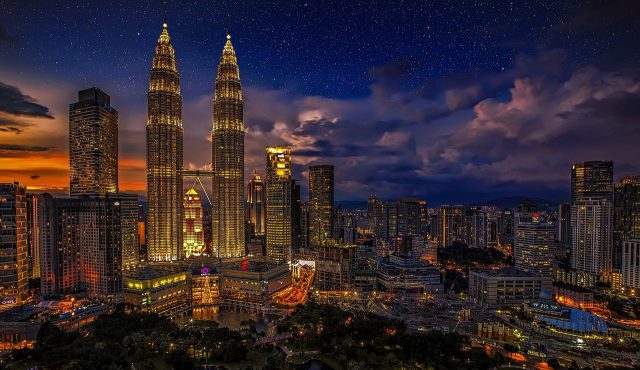
-
Wide Angle 24-35mm
They are used widely by photojournalists for documenting situations as they are wide enough to include a lot of the context whilst still looking realistic.

-
Standard 35mm-70mm
It’s in this range (at about 45-50mm) that the lens will reproduce what our eyes see. It is suitable for shooting on the street or with friends in a closed setting such as at the dinner table or the pub.
-
Mild Telephoto 70-105mm
This is a good range for portrait lenses as the natural perspective of the lens will separate the face from the background without completely isolating the face. It is also suitable for Close-up photography or macro photography.
-
Telephoto 105-300mm
Lenses in this range are often used for distant scenes such as sports, wildlife, and birds photography.
Conclusion
By being aware of the effects that your focal length will have on the resulting photos, you can set yourself up for shooting great photos. Nothing will teach you photography except practicing, so keep on practicing.
I hope you enjoyed reading the post and found it useful if you have any comments, questions, or need more clarification, please write it down below, and I will gladly answer your questions.
If you enjoy the site, remember to subscribe.





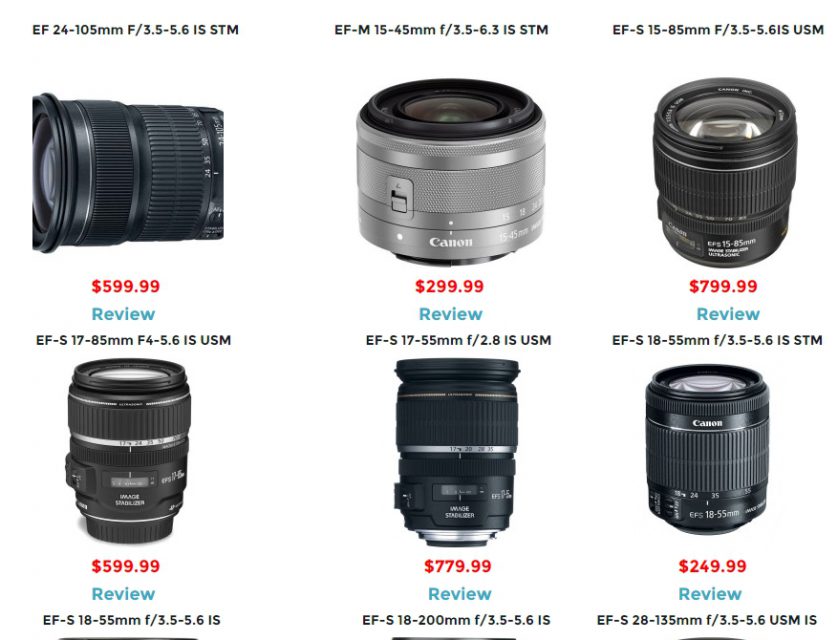
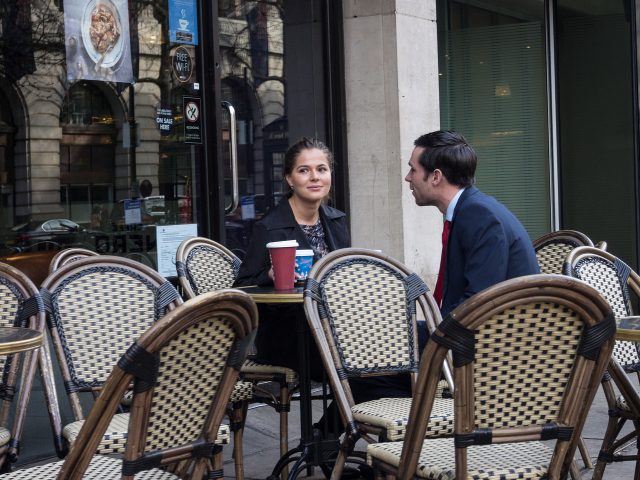

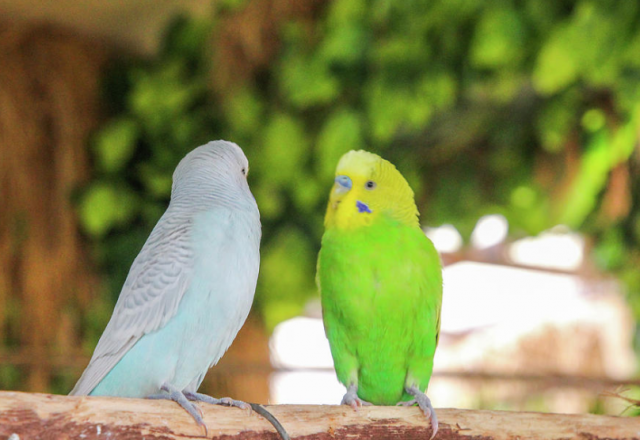


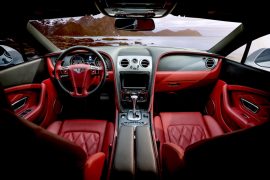

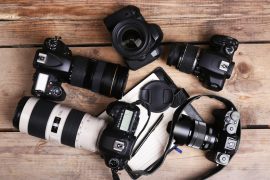
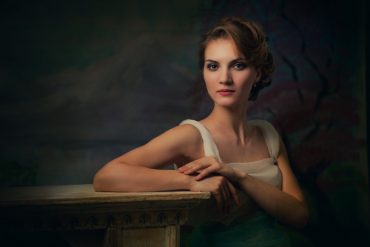
What a well detailed and and insightful review. I have used camera before and all but i have never thought of how these things works in such details.
This a whole hub of camera utilities and should be a hub for all professional photographers or aspiring ones for that matter.
The angling and the mathematical description of the whole mechanism is amazing and it is quit impressive to see how you put things together. Which of-cos means you knows your camera well.
Can i pick your brain please? what type of camera or lens would you recommend for someone who is about to embark on mountain climbing?. I have a friend who may need one.
Hi Richard
Thank you for your comprehensive comment, glad that you found the post interesting and helpful.
For you friend who is going to climb mountains, I would recommend the following links for you to consider when choosing the proper camera body and lens (which I presumed it would a lens that is suitable for landscape photos Top Canon DSLR cameras – Best 5 reviewed & Best canon lenses for landscape – Top 5 you need to know Thank you again and wish you good luck.